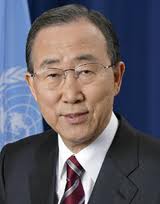 |
Global Assessment Report on Disaster Risk Reduction 2011
Revealing Risk, Redefining Development |


  |
FOREWORD Mr. Ban Ki-moon, Meanwhile floods in Australia and the devastating earthquake that hit Christchurch, New Zealand in early 2011 have shown how the economies and populations of developed countries are also increasingly exposed. The recent events in Japan point to new and catastrophic risks that need to be anticipated. While global climate change provides a backdrop to many of these events, they expose unresolved development problems that governments could and should address. Drawing on new and enhanced data, the 2011 report explores trends in disaster risk for each region and for countries with different socioeconomic development. At the same time, over 130 governments are engaged in self-assessments of their progress towards the Hyogo Framework for Action (HFA), contributing to what is now the most complete global overview of national efforts to reduce disaster risk. Progress is mixed. Mortality risk, from floods and tropical cyclones, is now trending down in all regions, as countries invest in improved early warning and preparedness. But economic loss risk and damage to homes, schools, health facilities and livelihoods is trending up. While the economies of many low- and middle-income countries are growing, it will take longer to tackle risks in a sustainable manner and develop institutions that successfully manage risks. Nevertheless, the report delivers some very good news: countries all over the world, from Indonesia and Mozambique to Panama and Yemen, are significantly improving their knowledge about disaster losses. Governments are using existing development instruments, such as conditional cash transfer and temporary employment programmes, in innovative ways to reach millions of risk-prone citizens. Public investments in infrastructure, health and education are becoming more risk-sensitive. These strategies have the potential to reduce disaster risk and achieve the objective of the HFA, which is critical to the achievement of the Millennium Development Goals and to adapt to global climate change. Seriously addressing disaster risk will be one of the hallmarks of good governance in the years to come. I encourage not only governments but all concerned citizens and organizations to study and make use of the recommendations of the 2011 Global Assessment Report on Disaster Risk Reduction, which indeed helps to reveal risk and redefine development.  Ban Ki-moon Secretary-General of the United Nations |
 |
x | |
 |
|
|
 |
||
  |
